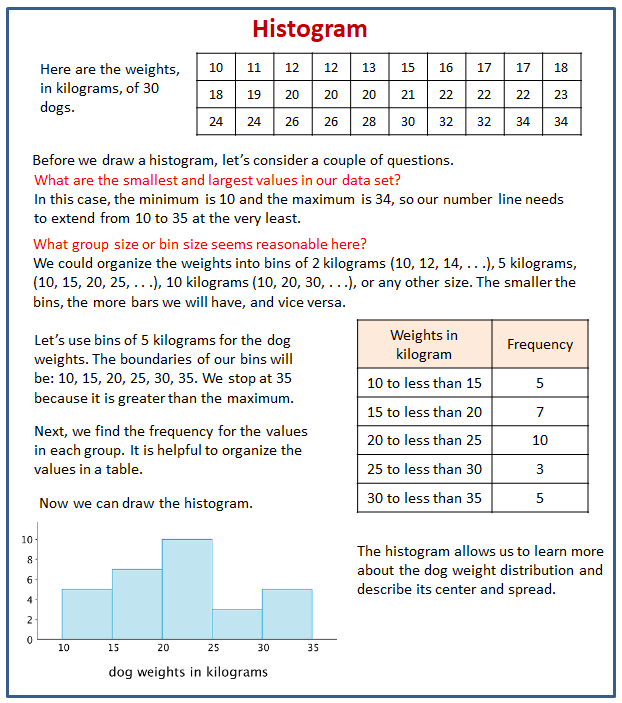Illustrative Mathematics Unit 6.8, Lesson 7: Using Histograms to Answer Statistical Questions
Learning Targets:
- I can draw a histogram from a table of data.
- I can use a histogram to describe the distribution of data and determine a typical value for the data.
Related Pages
Illustrative Math
Grade 6
Lesson 7: Using Histograms to Answer Statistical Questions
Let’s draw histograms and use them to answer questions.
Illustrative Math Unit 6.8, Lesson 7 (printable worksheets)
Lesson 7 Summary
The following diagram shows how to draw a histogram from a table of data.

Lesson 7.1 Which One Doesn’t Belong: Questions
Here are four questions about the population of Alaska. Which question does not belong? Be prepared to explain your reasoning.
- In general, at what age do Alaska residents retire?
- At what age can Alaskans vote?
- What is the age difference between the youngest and oldest Alaska residents with a full-time job?
- Which age group is the largest part of the population: 18 years or younger, 19–25 years, 25–34 years, 35–44 years, 45–54 years, 55–64 years, or 65 years or older?
Lesson 7.2 Measuring Earthworms
An earthworm farmer set up several containers of a certain species of earthworms so that he could learn about their lengths. The lengths of the earthworms provide information about their ages. The farmer measured the lengths of 25 earthworms in one of the containers. Each length was measured in millimeters.
- Using a ruler, draw a line segment for each length:
20 millimeters
40 millimeters
60 millimeters
80 millimeters
100 millimeters
a. Here are the lengths, in millimeters, of the 25 earthworms.
Complete the table for the lengths of the 25 earthworms. - Use the grid and the information in the table to draw a histogram for the worm length data. Be sure to label the axes of your histogram.
- Based on the histogram, what is a typical length for these 25 earthworms? Explain how you know.
- Write 1–2 sentences to describe the spread of the data. Do most of the worms have a length that is close to your estimate of a typical length, or are they very different in length?
Are you ready for more?
Here is another histogram for the earthworm measurement data. In this histogram, the measurements are in different groupings.
a. Based on this histogram, what is your estimate of a typical length for the 25 earthworms?
b. Compare this histogram with the one you drew. How are the distributions of data summarized in the two histograms the same? How are they different?
c. Compare your estimates of a typical earthworm length for the two histograms. Did you reach different conclusions about a typical earthworm length from the two histograms?
Lesson 7.3 Tall and Taller Players
Professional basketball players tend to be taller than professional baseball players.
Here are two histograms that show height distributions of 50 male professional baseball players and 50 male professional basketball players.
- Decide which histogram shows the heights of baseball players and which shows the heights of basketball players. Be prepared to explain your reasoning.
- Write 2–3 sentences that describe the distribution of the heights of the basketball players. Comment on the center and spread of the data.
- Write 2–3 sentences that describe the distribution of the heights of the baseball players. Comment on the center and spread of the data.
Lesson 7 Practice Problems
- These two histograms show the number of text messages sent in one week by two groups of 100 students. The first histogram summarizes data from sixth-grade students. The second histogram summarizes data from seventh-grade students.
a. Do the two data sets have approximately the same center? If so, explain where the center is located. If not, which one has the greater center?
b. Which data set has greater spread? Explain your reasoning.
c. Overall, which group of students—sixth- or seventh-grade—sent more text messages? - Forty sixth-grade students ran 1 mile. Here is a histogram that summarizes their times, in minutes. The center of the distribution is approximately 10 minutes.
On the blank axes, draw a second histogram that has:
a distribution of times for a different group of 40 sixth-grade students.
a center at 10 minutes.
less variability than the distribution shown in the first histogram. - Jada has d dimes. She has more than 30 cents but less than a dollar.
a. Write two inequalities that represent how many dimes Jada has.
b. Can d be 10?
c. How many possible solutions make both inequalities true? If possible, describe or list the solutions. - Order these numbers from greatest to least: -4, 1/4, 0, 4, -3 1/2, 7/4, -5/4
The Open Up Resources math curriculum is free to download from the Open Up Resources website and is also available from Illustrative Mathematics.
Try the free Mathway calculator and
problem solver below to practice various math topics. Try the given examples, or type in your own
problem and check your answer with the step-by-step explanations.

We welcome your feedback, comments and questions about this site or page. Please submit your feedback or enquiries via our Feedback page.